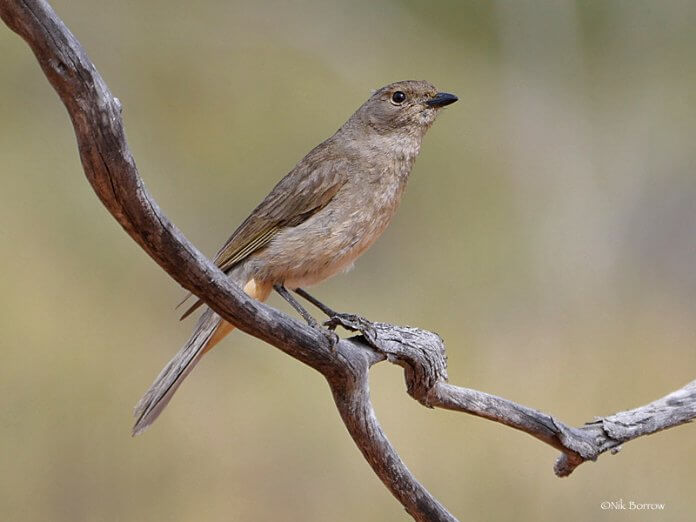DESCRIPTION
The beautiful Red-lored Whistler “Pachycephala rufogularis” is one of a group of three large whistlers that, are endemic to Australia. So far, there are nine species of Whistlers occurring in Australia. These birds live in shrubby undergrowth, and have stubby bills and bowed outermost flight feathers. And utter deliberate song notes of extraordinary richness and resonance. The other two are Olive and Gilbert’s Whistlers. Red-lored Whistler is basically a shy bird, inconspicuous and secretive with its mysterious behavior making it hard to see.
HABITATS
Of all species, the Red-lored Whistler is much the least known. But, indeed, the full extent of its distribution and habitat requirements has not become clear until the past decade or so. Whereas mallee broom bush “Melaleuca uncinata” communities were previously thought to be the core habitat, now it is known that the bird is centered in still wetter heath, of Banksia and stringy bark Eucalyptus baxteri, in the ninety miles big deserts across the South Australian-Victorian border.
Throughout its range, the Red-lored abuts Gilbert’s Whistler. The two seem to occupy mutually exclusive territories. That suggests that they compete; as a rule, Gilbert occupies the drier, more open habitat. Apart from dispersing young of the year, Red-lored Whistlers are sedentary birds. Which are established pairs holding territories in pockets of shrubby heath and broom bush in wet mallee woodland (a small area in New South Wales)
DIET/FOOD
They feed mainly on the ground, hopping methodically along undercover and into low branches, gleaning for food: large insects, larvae, and occasionally berries and seeds.
IDENTIFICATION
MALE: Upper parts dark gray. Wings and tail duskier, edged with pale gray. There are lores and throat cinnamon-rufous, with a mid-gray band across the upper breast. The lower breast to under-tail is cinnamon-rufous, flanks grayer. The eye is ruby, the bill is black the feet are black-brown. FEMALE: As male; paler gray upperparts and paler cinnamon-rufous on lores, throat, and underparts. IMMATURE: Upper parts as female; underparts streaked dusky; lores white; eye and bill deep brown. Juveniles washed plain russet-brown (The juvenile upper parts and flanks; underparts white-streaked dusky; tail feathers pointed). Juvenile plumage moults out within a month or so of fledging.
VOICE CALL
Red-lored Whistlers are sedentary birds; however the call is low, charming, wistful, and in drawn plaintive whistle. It has many varied calls, sometimes chew-chew-chew, and other soulful notes.
SONG
Red-lored Whistlers Resonant and far-carrying, by male song, is welling, repeated whistles seeee-saw-saw-saw. Thus, the first note is a little longer and up-slurred, concluding two or three shorter and progressively dropping in pitch. Also, this is explosive and repeated chop-chop-chop in long series on the same pitch.
BREEDING
Out of breeding, the whistlers are silent, secretive, and solitary in their feeding. In spring, however, males hop and fly up to bare vantage perches in the mallee mid-stage to sing sporadically through the day. Singing males throw up their heads as they call. Both members of the pair construct the nest, working the material in alternately and giving a faint chuckle before flying off for more. Unlike Gilbert’s Whistler, which uses only dead material, the Red-lored incorporates some greenery into the walls and lining. Both sexes incubate and brood and feed the young.
NESTING
The breeding season starts from September till December. They build a nest in a substantial cup, mainly of coarse bark and mallee leaves. That is neatly when around the rim; lined with fine bark shreds, rootlets, grass, and tips of bushes or green twining plants. The nest is placed within 0.5 m of ground, in a forked branch of mallee, in a clump of porcupine grass Triodia, or in stout shrubs, such as broom bush. The bird lays two or three pale buffs to white eggs, sparingly marked with umber-brown, with blurred lavender streaks. Normally the size of eggs is about 24 x 17 mm. Moreover, the incubation period is about 15 days, for both sexes.
DISTRIBUTION
Healthy mallee tracts of southeastern South Australia, northwestern Victoria, and southwestern New South Wales, with an isolated outlier in mallee in Midwestern New South Wales between Pulletop and Round Hill Nature Reserves. But the identity of the Midwestern New South Wales population was not established.
FLIGHT
Red-lored Whistler flies little and only in swift, often low undulations between bushes.
ALTERNATIVE NAMES This bird is also known as Red-throated Whistler, Rufous-throated Thick head, and Buff-breasted Whistler.
LENGTH
The Red-lored Whistler is a medium size bird with a length of 200-210 mm.
AGE
In the wild, the post-fire age of 20 to 40 years. However, the preferred vegetation has a post-fire age of 5 to 40 years.
Read More – Grey Whistler – A Bird That Haunts Hearts




Read More – Difference Between a Tree Sparrow and House Sparrow






